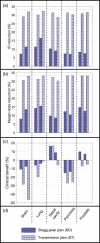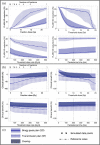A quantitative FLASH effectiveness model to reveal potentials and pitfalls of high dose rate proton therapy
- PMID: 35032035
- PMCID: PMC9305944
- DOI: 10.1002/mp.15459
A quantitative FLASH effectiveness model to reveal potentials and pitfalls of high dose rate proton therapy
Abstract
Purpose: In ultrahigh dose rate radiotherapy, the FLASH effect can lead to substantially reduced healthy tissue damage without affecting tumor control. Although many studies show promising results, the underlying biological mechanisms and the relevant delivery parameters are still largely unknown. It is unclear, particularly for scanned proton therapy, how treatment plans could be optimized to maximally exploit this protective FLASH effect.
Materials and methods: To investigate the potential of pencil beam scanned proton therapy for FLASH treatments, we present a phenomenological model, which is purely based on experimentally observed phenomena such as potential dose rate and dose thresholds, and which estimates the biologically effective dose during FLASH radiotherapy based on several parameters. We applied this model to a wide variety of patient geometries and proton treatment planning scenarios, including transmission and Bragg peak plans as well as single- and multifield plans. Moreover, we performed a sensitivity analysis to estimate the importance of each model parameter.
Results: Our results showed an increased plan-specific FLASH effect for transmission compared with Bragg peak plans (19.7% vs. 4.0%) and for single-field compared with multifield plans (14.7% vs. 3.7%), typically at the cost of increased integral dose compared to the clinical reference plan. Similar FLASH magnitudes were found across the different treatment sites, whereas the clinical benefits with respect to the clinical reference plan varied strongly. The sensitivity analysis revealed that the threshold dose as well as the dose per fraction strongly impacted the FLASH effect, whereas the persistence time only marginally affected FLASH. An intermediate dependence of the FLASH effect on the dose rate threshold was found.
Conclusions: Our model provided a quantitative measure of the FLASH effect for various delivery and patient scenarios, supporting previous assumptions about potentially promising planning approaches for FLASH proton therapy. Positive clinical benefits compared to clinical plans were achieved using hypofractionated, single-field transmission plans. The dose threshold was found to be an important factor, which may require more investigation.
Keywords: FLASH; effectiveness model; scanned proton therapy.
© 2022 Varian Medical Systems. Medical Physics published by Wiley Periodicals LLC on behalf of American Association of Physicists in Medicine.
Conflict of interest statement
MK and MMF are employees of Varian Medical Systems. SvdW received funding from the EU‐H2020 project “INSPIRE” (INfraStructure in Proton International REsearch; grant ID: 730983).
Figures






References
-
- Favaudon V, Caplier L, Monceau V, et al. Ultrahigh dose‐rate FLASH irradiation increases the differential response between normal and tumor tissue in mice. Sci Transl Med. 2014;6:245ra93. - PubMed
-
- Montay‐Gruel P, Bouchet A, Jaccard M, et al. X‐rays can trigger the FLASH effect: ultra‐high dose‐rate synchrotron light source prevents normal brain injury after whole brain irradiation in mice. Radiother Oncol. 2018;129:582‐588. - PubMed
-
- Hornsey S, Bewley DK. Hypoxia in mouse intestine induced by electron irradiation at high dose‐rates. Int J Radiat Biol Relat Stud Phys Chem Med. 1971;19:479‐483. - PubMed
-
- Montay‐Gruel P, Petterson K, Jaccard M, et al. Irradiation in a flash: unique sparing of memory in mice after whole brain irradiation with dose rates above 100 Gy/s. Radiother Oncol. 2017;124:365‐369. - PubMed
MeSH terms
Substances
Grants and funding
LinkOut - more resources
Full Text Sources
Other Literature Sources

